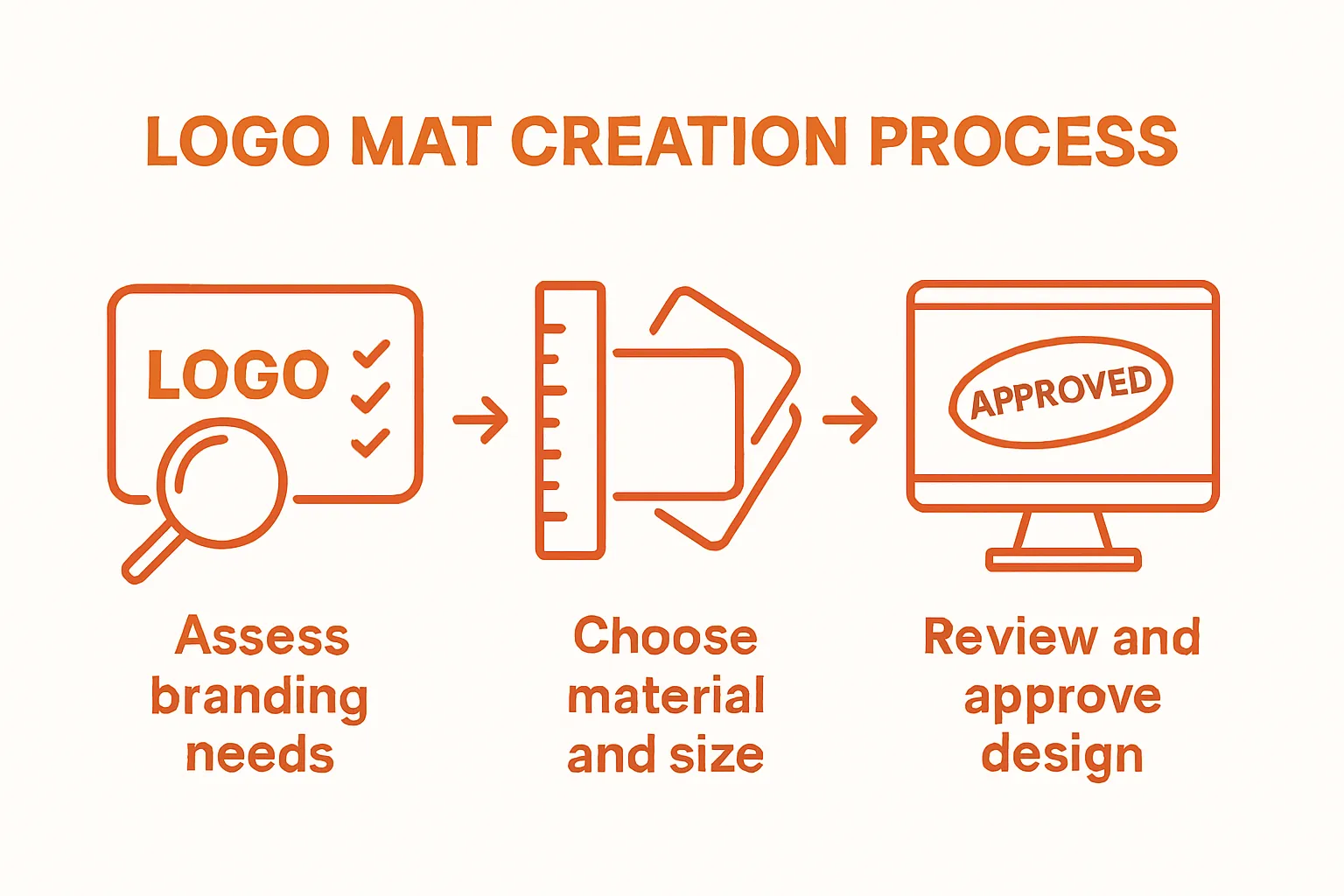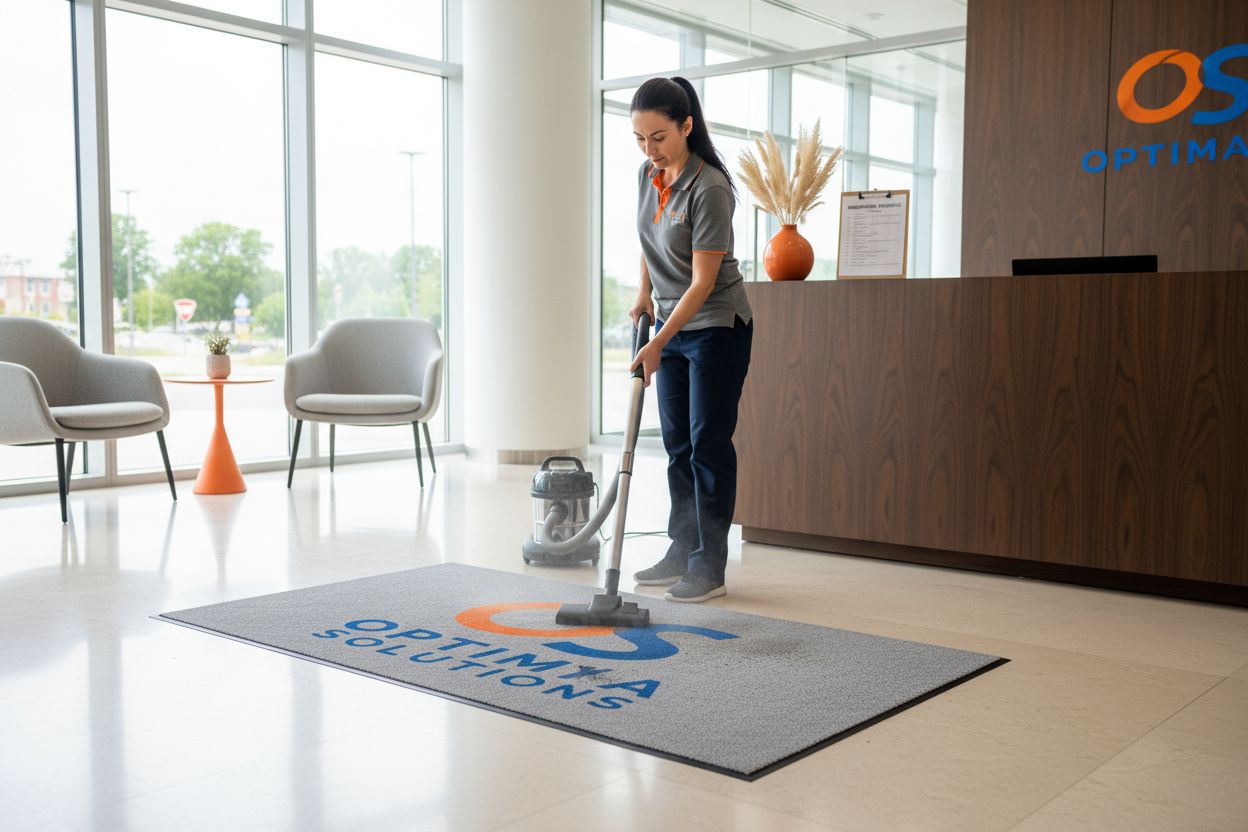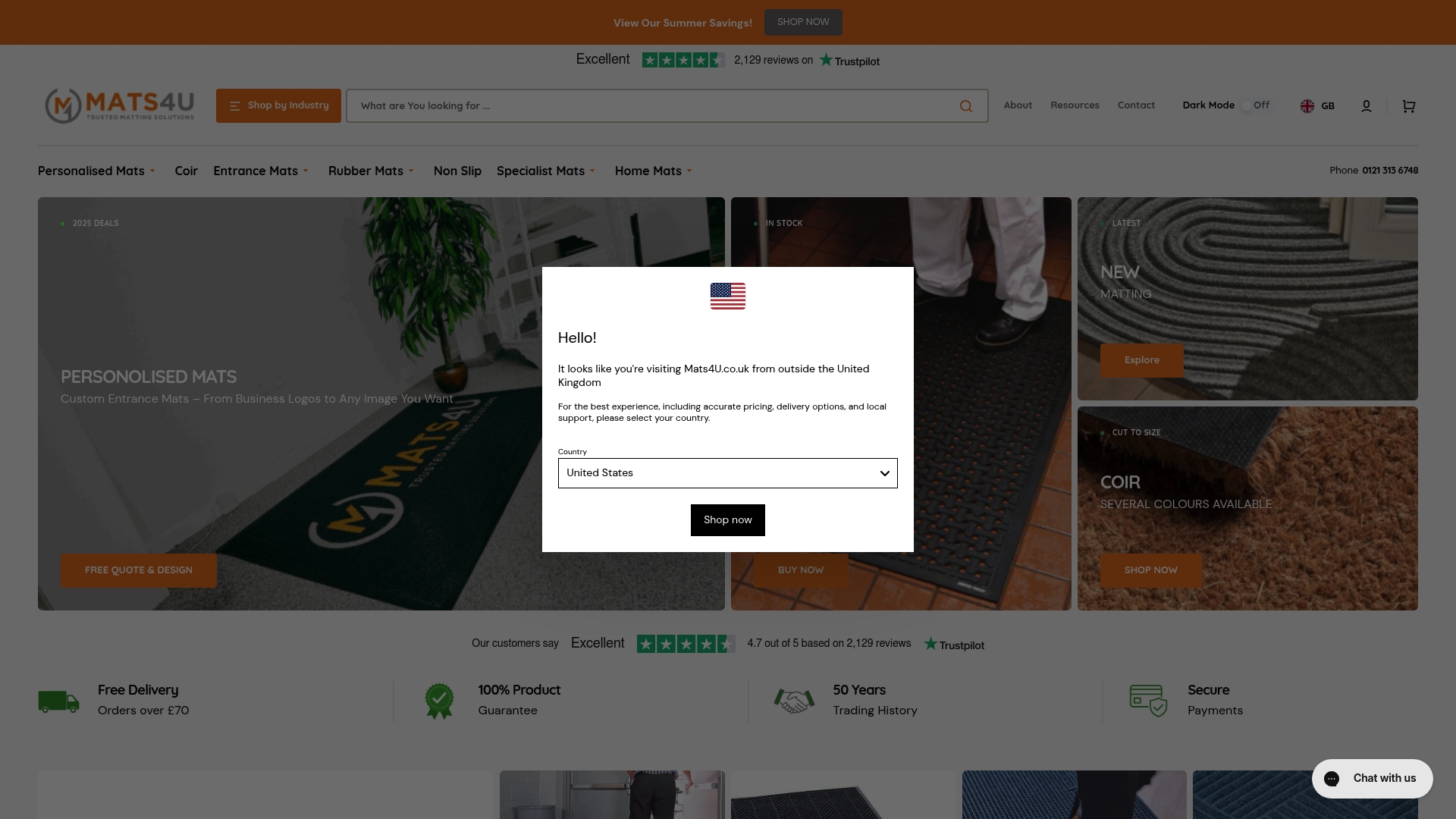Custom logo mats sit quietly at the entrance of countless businesses, yet their impact goes far beyond simple decor. In fact, entrance mats covering at least 80 percent of doorway width can dramatically reduce tracked-in dirt and moisture, leading to cleaner spaces and a stronger first impression. Most people see only a mat, but every time a visitor steps through your door, your brand gets a silent spotlight.
Table of Contents
- Step 1: Assess Your Branding Needs For Custom Logo Mats
- Step 2: Choose The Right Material And Size For Your Mats
- Step 3: Design Your Custom Logo And Gather Requirements
- Step 4: Select A Reliable Supplier For Production
- Step 5: Review Proofs And Approve Your Custom Logo Mats
- Step 6: Install And Maintain Your Mats For Lasting Impact
Quick Summary
| Key Point | Explanation |
|---|---|
| 1. Assess your branding needs thoroughly | Conduct a brand audit to align your logo mat design with your visual identity and functional requirements. |
| 2. Select suitable materials and size | Choose appropriate materials based on foot traffic and environmental conditions to ensure durability and visual effectiveness. |
| 3. Create high-resolution logo designs | Use vector files for logo clarity and correctness, ensuring the design is bold and easy to recognize from various distances. |
| 4. Choose a reputable supplier | Evaluate potential manufacturers for expertise, reliability, and quality to maximize the longevity of your investment. |
| 5. Maintain and monitor your mats regularly | Implement a structured cleaning routine and monitor for wear to extend the mats’ lifespan and maintain brand visibility. |
Step 1: Assess Your Branding Needs for Custom Logo Mats
Creating custom logo mats begins with a strategic assessment of your brand’s visual identity and functional requirements. This critical first step ensures that your custom logo mats are not just decorative elements but powerful marketing tools that communicate your brand’s essence from the moment someone enters your space.
Start by conducting a comprehensive brand audit that examines your existing visual elements. Review your company’s logo, colour palette, and core messaging to determine how these can be effectively translated onto a floor mat. Consider the primary environments where these mats will be placed - whether in corporate reception areas, retail entrances, or industrial settings. Each location demands a slightly different approach to design and durability.
Your brand assessment should focus on several key dimensions. Examine the colour psychology of your brand’s palette and how these colours interact with different floor surfaces and lighting conditions. Some brands opt for bold, high-contrast logos that immediately capture attention, while others prefer subtle, sophisticated designs that blend seamlessly with their interior aesthetics. Learn more about maximising your brand visibility to understand how strategic mat placement can amplify your marketing efforts.
Take precise measurements of the spaces where logo mats will be installed. This technical consideration is crucial for ensuring a perfect fit and professional appearance. Consider the foot traffic volume, potential wear and tear, and environmental conditions. A logo mat for a busy corporate headquarters will require different material specifications compared to one designed for a boutique retail space or a quiet office reception area.
To help compare the available materials for custom logo mats highlighted in the guide, refer to the following table which outlines their suitability and key characteristics.
| Material | Best For | Key Features |
|---|---|---|
| Nylon | High-traffic indoor areas | Excellent durability, colour retention |
| Polyester | General commercial environments | Good image clarity, durable, vibrant colours |
| Rubber | Outdoor, moisture-prone areas | Superior water resistance, anti-slip properties |
| Polypropylene | Outdoor, industrial entrances | Water-resistant, good grip, economical |
| Coir (natural) | Traditional entrances | Eco-friendly, textured for scraping dirt |
Finally, validate your design choices by creating digital mockups or requesting sample prototypes. This allows you to evaluate how your brand translates onto a floor mat before making a full commitment. Pay attention to logo clarity, colour accuracy, and overall visual impact. The goal is to create a custom logo mat that not only represents your brand authentically but also provides practical functionality in its designated environment.

Step 2: Choose the Right Material and Size for Your Mats
Selecting the appropriate material and size for your custom logo mats is a pivotal decision that determines their performance, durability, and visual impact. This step requires careful consideration of your specific environment, foot traffic patterns, and branding objectives.
Material selection forms the foundation of an effective logo mat strategy. Synthetic materials like nylon and polyester offer exceptional durability and colour retention, making them ideal for high-traffic commercial spaces. For outdoor or moisture-prone areas, rubber and polypropylene provide superior water resistance and grip. Explore our guide on understanding made to measure mats to gain deeper insights into material specifications.
Size determination follows a strategic approach that balances functional coverage with aesthetic considerations. According to industry experts, entrance mats should cover at least 80% of doorway width and be long enough to capture dirt from two complete footsteps. This ensures maximum soil and moisture containment while presenting a professional appearance.
Consider the specific environmental challenges of your space. Corporate lobbies with polished floors require different mat specifications compared to industrial warehouses or retail environments. Thickness and pile height play crucial roles in trapping dirt and providing comfort. Thicker mats with higher pile work excellently in areas with significant moisture or debris, while thinner mats suit indoor spaces with lighter foot traffic.
Practical measurement involves more than simple length and width calculations. Assess the total square meterage required, accounting for potential future expansion or repositioning. Most businesses benefit from modular mat systems that can be easily replaced or expanded. Take precise measurements of doorways, corridors, and reception areas, allowing a small buffer for potential installation variations.
Your final material and size selection should harmonise functionality with brand representation. A well-chosen mat not only captures dirt and provides safety but also serves as a silent brand ambassador, greeting visitors with your logo and colour palette from the moment they enter your space.
Step 3: Design Your Custom Logo and Gather Requirements
Designing a custom logo mat requires a meticulous approach that balances visual appeal with practical brand communication. This critical step transforms your brand identity into a functional marketing tool that makes an immediate impression on visitors and customers.
High-resolution digital files form the foundation of an exceptional logo mat design. Work with a professional graphic designer or use your company’s approved brand guidelines to ensure accuracy. Vector formats like AI or EPS are preferable, as they maintain crisp edges and allow seamless scaling without losing image quality. Avoid low-resolution JPG or PNG files that might appear pixelated or blurred when translated onto mat materials.
Logo design experts recommend creating designs that are bold, simple, and instantly recognisable. Complex logos with intricate details often lose their impact when reproduced on floor surfaces. Consider how your logo will appear from different angles and distances, keeping the design clean and legible. Colour selection is paramount - choose hues that complement your mat’s base material and provide sufficient contrast for maximum visibility.
Technical requirements demand precise specifications. Measure the exact dimensions of your intended mat placement and determine the maximum logo size that will look proportional. Some businesses opt for full-coverage designs, while others prefer subtle logo placements that hint at brand identity without overwhelming the visual space. Communicate clearly with your mat manufacturer about colour matching, requiring specific Pantone or RGB references to ensure brand consistency.
Gather comprehensive background information that will inform your design process. This includes understanding your target environment’s lighting conditions, floor surface type, and typical foot traffic patterns. A logo mat for a bright, modern reception area will have different design considerations compared to an industrial warehouse entrance. Consider how colours and design elements might interact with different lighting and surface textures.
Verify your design by requesting a digital proof or small-scale prototype before full production. This allows you to assess colour accuracy, logo placement, and overall visual impact without committing to a large order. A well-executed logo mat serves as a silent brand ambassador, transforming a functional floor covering into a powerful marketing asset that communicates your brand’s professionalism from the moment someone steps inside your space.
Step 4: Select a Reliable Supplier for Production
Choosing the right supplier for your custom logo mats is a pivotal decision that can significantly impact your brand’s visual representation and long-term investment. This step requires a comprehensive evaluation of potential manufacturers who can transform your design vision into a high-quality, durable product.
Industry reputation and specialisation should be your primary consideration when selecting a supplier. Look for manufacturers with proven expertise in custom logo mat production, particularly those with experience in your specific industry sector. Seek out suppliers who can demonstrate a portfolio of similar projects, showcasing their ability to handle complex branding requirements and maintain consistent quality across different materials and design specifications.
Research indicates that investing in a quality supplier can result in mats that last 3-5 years, making your initial investment more cost-effective in the long run. Request comprehensive samples that demonstrate the supplier’s colour matching capabilities, printing precision, and material durability. These samples should closely replicate the environmental conditions where your logo mats will be deployed.
Technical capabilities form another crucial evaluation criterion. Engage potential suppliers in detailed discussions about their production processes, colour reproduction techniques, and quality control measures. Inquire about their printing technologies - whether they use screen printing, digital printing, or dye sublimation methods. Each technique offers different advantages in terms of colour vibrancy, detail reproduction, and long-term wear resistance.
Consider the supplier’s additional services and support. The most valuable partners offer comprehensive solutions beyond simple mat production. This might include design consultation, material recommendations, installation guidance, and aftercare advice. Look for suppliers who demonstrate a collaborative approach, willing to work closely with you to refine your design and ensure optimal results.
Financial and logistical considerations are equally important. Request detailed quotes that break down all costs, including design setup, production, and shipping. Compare these transparently, but avoid selecting solely on the lowest price. A marginally higher investment in a reputable supplier can prevent costly redesigns or premature mat replacement. Verify their production lead times, minimum order quantities, and return or replacement policies to ensure they align with your business requirements.
Ultimately, selecting the right supplier is about finding a partner who understands your brand’s unique requirements and can translate your vision into a high-performance logo mat that makes a lasting impression.
Step 5: Review Proofs and Approve Your Custom Logo Mats
Reviewing and approving proofs represents the critical transition point between design concept and final product, where your custom logo mat transforms from digital mockup to tangible brand representation. This stage demands meticulous attention to detail and a systematic approach to quality verification.
Digital proofs require comprehensive visual scrutiny. Examine the electronic representation with a discerning eye, checking every aspect of colour reproduction, logo placement, and overall design integrity. Pay particular attention to how your brand colours translate across different digital representations, as monitor calibration can significantly impact perceived colour accuracy. According to industry research, maintaining high-quality visuals signals professional value and prevents potential brand perception issues.
Request physical colour swatches and material samples alongside digital proofs to ensure absolute colour matching. Colours can appear dramatically different depending on material texture and lighting conditions. Natural daylight, fluorescent office lighting, and ambient warehouse illumination will each interact uniquely with your mat’s surface. Compare proofs against your original brand guidelines, checking that every nuance of your corporate identity is precisely represented.
Technical specifications demand equal scrutiny. Verify dimensions, ensuring the mat fits precisely in its intended location with minimal gaps or overhang. Check resolution and print clarity, particularly for logos with fine details or complex graphical elements. Zoom in digitally to confirm edge sharpness and colour blending, which can reveal potential production limitations before final manufacturing begins.
Establish a structured review process with clear communication channels between your design team and the mat manufacturer. Create a formal approval document that outlines specific acceptance criteria, including colour accuracy, logo placement, material quality, and dimensional specifications. This documentation serves as a legal and professional safeguard, ensuring both parties have a clear understanding of expectations.
Before final approval, simulate real-world usage scenarios. Consider how the mat will appear when subjected to foot traffic, potential moisture, and varying light conditions. A proof that looks perfect in a controlled environment might reveal unexpected characteristics when deployed in your actual business setting. Your goal is to approve a logo mat that not only looks exceptional but performs consistently across diverse environmental challenges.
Step 6: Install and Maintain Your Mats for Lasting Impact
Installation and ongoing maintenance represent the final, crucial stages that transform your custom logo mats from mere design concepts into powerful, long-lasting brand ambassadors. This step ensures your investment continues to deliver visual impact and functional performance throughout its lifecycle.
Proper installation begins with precise surface preparation. Thoroughly clean and level the target area, removing any dust, debris, or uneven surfaces that might compromise mat placement. For indoor environments, consider using double-sided adhesive or discrete fixing systems that maintain a smooth, professional appearance. Outdoor and high-traffic areas may require more robust anchoring methods to prevent mat shifting or potential tripping hazards.
Regular maintenance is essential for preserving both the aesthetic and functional qualities of your logo mats. Develop a structured cleaning routine that matches the specific material and usage environment. Read more about commercial mat cleaning to understand the nuanced approaches required for different mat types.
Vacuuming remains the primary maintenance technique for most custom logo mats. Use gentle, consistent strokes to remove loose dirt and prevent particle accumulation that could degrade mat fibres or obscure your brand’s visual identity. For mats in high-moisture areas, implement more frequent deep cleaning protocols that address potential mould or mildew risks. Professional cleaning services specialising in commercial matting can provide periodic deep cleaning that rejuvenates your mat’s appearance.
Monitor your logo mats continuously for signs of wear, colour fading, or structural degradation. Early intervention prevents minor issues from becoming costly replacements. Pay special attention to high-traffic zones where logo definition might diminish more quickly. Consider rotating mats periodically to ensure even wear and extend overall product lifespan.
Document your maintenance schedule, tracking cleaning frequencies, professional servicing dates, and any repairs or replacements. This systematic approach not only preserves your mat’s quality but also provides valuable insights into long-term performance and potential future design improvements. Your custom logo mat is more than a floor covering—it’s a dynamic marketing tool that requires thoughtful, consistent care to maintain its brand-enhancing potential.
For a quick reference to the entire process, the following table summarises each main step of creating custom logo mats, along with its key objective and outcome.
| Step | Objective | Key Outcome |
|---|---|---|
| Assess Branding Needs | Align mats with brand identity and environment | Clear requirements and strategic fit |
| Choose Material & Size | Select appropriate material and dimensions | Durable, effective mat suited to location |
| Design and Requirements | Develop impactful, high-resolution logo design | Print-ready, visually strong artwork |
| Select Supplier | Pick reputable, capable manufacturer | Reliable production and service |
| Review and Approve Proofs | Check design, colours, accuracy before production | Guaranteed satisfaction and correctness |
| Install & Maintain | Ensure correct placement and regular upkeep | Long-lasting, professional brand visibility |

Instantly Boost Your Brand with Professional Custom Logo Mats
Are you struggling to translate your brand identity onto your physical premises? The article highlighted how vital high-quality custom logo mats are for making a strong, immediate impact on visitors. If you want your brand to be the first thing customers notice, you need more than just any mat. You need the perfect blend of professional design, quality material, and precise customisation. Businesses in high-traffic sectors such as hospitality or the retail industry know that first impressions are lasting. Discover our wide range of tailored solutions on Hotel & Leisure Mats and see how a made-to-measure approach can transform entrances in venues small and large. See your brand’s message delivered the moment anyone walks through the door.

Do not settle for generic mats that fade into the background. Visit Mats4U today to start your journey with our fully customisable logo mat options, designed to support your brand’s visibility and professional image. Take the next step now and see how our expertise in Retail Industry Mats can help your business leave a memorable mark. Act now to secure a tailored solution that reflects your company’s personality and stands up to daily footfall. Your brand deserves to be seen.
Frequently Asked Questions
What materials are best for custom logo mats?
Synthetic materials like nylon and polyester are ideal for high-traffic commercial spaces due to their durability and colour retention. Rubber and polypropylene are preferred for outdoor or moisture-prone areas for superior water resistance and grip.
How should I choose the size for my logo mat?
The size of the logo mat should cover at least 80% of the doorway width and be long enough to capture dirt from two complete footsteps. Accurate measurements of the installation area are essential for a perfect fit and professional appearance.
What design elements should I consider for my custom logo mat?
Your design should be bold, simple, and instantly recognisable. Use high-resolution vector files for clarity, and ensure that the colours complement the mat’s base material for maximum visibility. Avoid intricate details that may lose impact when reproduced on the mat.
How can I maintain my custom logo mats for longevity?
Regular vacuuming is important to remove dirt and maintain the mat’s appearance. Develop a structured cleaning routine based on the material type, and consider professional cleaning services for deep cleans. Regularly monitor for wear and rotate mats to ensure even usage.
Recommended
- Maximise Your Brand Visibility with Branded Mats – Mats4U
- The Ultimate Guide to Coir Logo Mats: Enhance Your UK Business Entranc – Mats4U
- Understanding Made to Measure Mats: Benefits and Uses – Mats4U
- Master Commercial Mat Cleaning for Pristine Results – Mats4U
- Benefits of Custom 3D Signs for Retail and Commercial Spaces
- 7 Voorbeeld Branding Materialen voor Kleine Ondernemers - Logoknaller – Uniek logo laten maken voor zzp & starters









